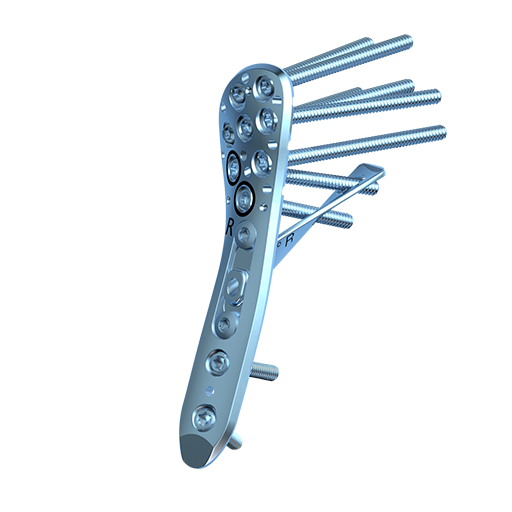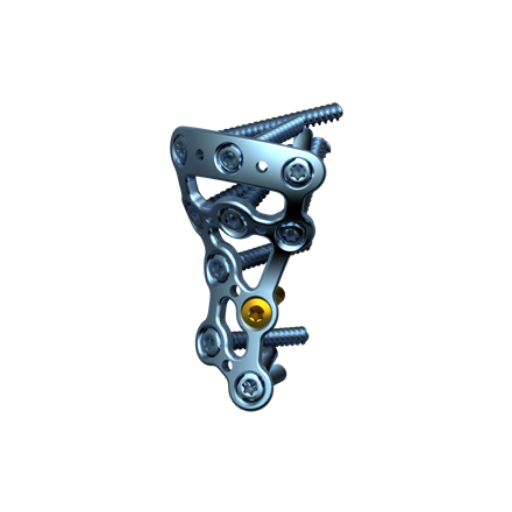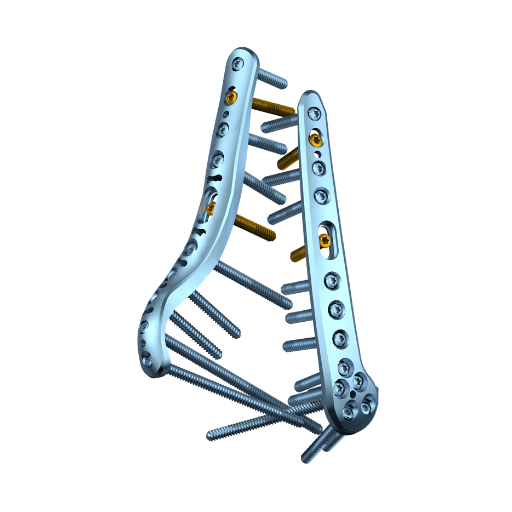Stability Redefined
The APTUS Clavicle system provides surgeons with a versatile and anatomical solution to treat midshaft and distal fractures, osteotomies, malunions and non-unions of the clavicle. The system includes for superior and anterior clavicle plating. A flexible suture retrieval and fixation system can be added to the superior lateral plates to address affected CC ligaments. The efficient and user-oriented system is backed up with easy to use instrumentation and innovative features to live up to its attention to stability.
Flaps

Plate slot to hold an insert for either a cortical screw or suture fixation.
Two flaps for screws from anterior to posterior to increase stability.
Dimples

Dimples on plate surface – plate can be easily held in position with pointed forceps.
Drill Guide Blocks

Drill guide blocks for superior lateral plates – rapid and easy insertion of screws in a predefined angle.
TriLockPLUS

TriLockPLUS screw holes offer the advantage of compression and angular stable locking in one step.
Fracture Location
Clavicle fractures are common injuries, accounting for up to 10% of all fractures in adults. They often result from direct impact to the shoulder. Shaft fractures are the most frequent clavicle fractures followed by lateral and medial fractures. CC joint injuries are often associated with lateral clavicle fractures. [1] The Medartis APTUS Clavicle System 2.8 takes this into account, providing a portfolio designed to cover a variety of fracture positions. All plates have an anatomic plate design with a low overall profile height and specific design features, such as CC suture fixation directly through the lateral superior plates. [1] Boonard, M., et al., Fixation method for treatment of unstable distal clavicle fracture: systematic review and network meta-analysis. Eur J Orthop Surg Traumatol, 2018. 28(6): p. 1065-1078."
Clavicle Superior Midshaft Plates

Highlights
-
Anatomical fit developed based on CT data
-
8-hole plates in three bend variations. Straightforward anatomical fit on variously shaped bones with reduced need for plate bending
Features
Anterior Midshaft Plates

Highlights
-
Symmetrical plate design based on CT data
-
Low plate profile with minimal screw head protrusion, rounded edges and a smooth surface
-
Chamfered and narrowed plate ends with preangled screw holes
Features
Clavicle Superior Lateral Plate

Highlights
-
Two flaps for screws from anterior to posterior allow for screw placement in two planes and increase the possibilities to address fragments
-
Multiple screw holes and increased pull-out strength in the lateral area for various fracture patterns
-
Plate slot to hold an insert offers the possibility to fix a suture through the plate or alternatively to place a cortical screw
-
The optional drill guide block facilitates rapid and accurate screw insertion at a predefined angle
Features
Clavicle Anterior Lateral Plates

Highlights
-
Chamfered and narrowed plate ends with preangled screw holes
-
Designed for less invasive plate placement and fixation method
-
Low plate profile with minimal screw head protrusion, rounded edges and a smooth surface for soft tissue protection
Features
Clavicle Superior Lateral Shaft Plate

Highlights
-
Specific anatomical fit offers the possibility to position the plate laterally, but away from the AC joint
-
Multiple options for screw placement to increase pull-out strength in the lateral area
-
Narrowed lateral plate end with reduced plate thickness
-
Preangled screw hole in the medial plate end
Features
Technological Milestones in Osteosynthesis
TriLock
Multidirectional and angular stable locking, screws can pivot freely by ± 15° in all directions
TriLockPLUS
TriLockPLUS screw holes offer the advantage of locking and compression in one step
HexaDrive
Simplified screw pick-up due to self-holding system
Designed to Organize

Due to only one screw size used the system is user-friendly and efficient. The simple and easy to use instruments include finely adjusted ratcheting on the reduction instruments.
- Compact system
- Easy to use
- Lightweight components
- Validated cleaning and sterilization of the implants
Explore Various Perspectives
Medartis Patient Story Clavicle System 2.8 – Gilles Müller
Treatment of an artifical lateral Clavicle fracture
Treatment of an artifical midshaft Clavicle fracture
Documentation
Results
- Clavicle System 2.8 - Surgical Technique 13.05.2024 5 MB Surgical Technique Upper Extremities English
- Case Study - ORIF of displaced lateral clavicle fracture with the APTUS 2.8 Clavicle System - Dr. Michael Hack 13.05.2024 662 KB Case Study Upper Extremities English
- Case Study - Fixation of a Displaced Neer Type IIA Fracture with the APTUS 2.8 Superior Lateral Shaft Plate - Mr. Andrew C. Wright 13.05.2024 951 KB Case Study Upper Extremities English
- Case Study - Management of recalcitrant non-union of the clavicle with a free vascularized medial femoral condyle corticoperiosteal bone flap - Dr. Eugene Ek 13.05.2024 2 MB Case Study Upper Extremities English
- APTUS Ordering Catalog/Bestellkatalog/Catalogue (High Resolution) (Version 0, MDR) 18.01.2024 22 MB Ordering Catalog Upper Extremities English
- APTUS Ordering Catalog/Bestellkatalog/Catalogue (Low Resolution) (Version 0, MDR) 18.01.2024 16 MB Ordering Catalog Upper Extremities English
- Clavicle System 2.8 – Product Information 17.11.2023 4 MB Product Information Upper Extremities English
- Clavicle System 2.8 – White Paper 17.11.2023 1 MB White paper Upper Extremities English












